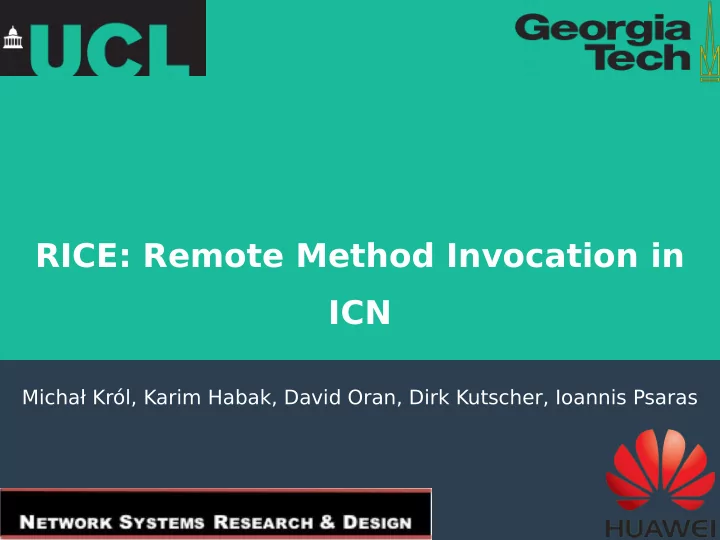

RICE: Remote Method Invocation in ICN Michał Król, Karim Habak, David Oran, Dirk Kutscher, Ioannis Psaras
It’s NOT about ● RPC, CORBA, Java RMI ● Tightly-coupled system from (not so) long time ago 2
Static data retrieval Give me data 4
In-network computation Compute this for me c 5
In-network computation ● Multiple use-cases – edge/fog computing, IoT, VR/AR ● Multiple existing frameworks: NFN, NFaaS, CCNxServe, SCN, NextServe ● Migrate functions where they’re needed the most ● Populate FIB tables with routes to services 6
Anycast No need for a DNS/SDN server 7
Load control 8
Result caching c c 9
Issues 10
Client Authorization 11
Large Parameter Passing 12
Accommodating non-trivial computations PIT expires 13
Accommodating non-trivial computations 14
RICE Design 15
Design Goals ● Consumer authentication and authorization ● Large parameter passing ● Accommodating non-trivial computations ● Allow result caching ● Adhere to ICN principles – Pull model – Avoid revealing permanent client identifers – Support client mobility ● Make minimal changes to ICN protocols and forwarder behaviour 16
Naming
4-way Handshake ● Enable 2-way communication between producers and consumers ● Shared Secret Derivation ● Client Authentication ● Large Input Parameters Submission 19
4-way Handshake
Dynamic Content Retrieval 21
Network and Application Timescale ● PIT entries use timeouts ● When requesting static content Interest Satisfaction Time equals RTT ● Generating dynamic content adds a delay that is unknown to the network ● PIT entries can expiry before returning the results 22
Network Timescale Application Timescale ● Fast recovery ● Low overhead ● No assumption on ● Regular Bandwidth execution time allocation ● Huge overhead ● Slow Recovery ● Challenging ● Requires a lot of bandwidth knowledge allocation We want to decouple application timescale from network timescale
Thunks
Network Timescale
Application Timescale
Acknowledgements
Results 29
Handshake 30
Thunks 31
Thunks 32
Referentially opaque function 33
Referentially transparent function 34
Thunks
Prototype 36
Limitations ● Thunks require accurate computation time estimation – Overestimation increases the delay – Underestimation increases overhead ● Referentially transparent functions can be cached under diferent names – Can be solved by using forwarding hints 37
Conclusion and Future Work ● Client authentication, large parameter passing, accommodating non-trivial computation using a 4-way handshake + thunks ● Generic API for function invocation ● RICE can be a basis for many NFN- inspired systems. ● Prototype and demo 38
In the future ● Integration with routing hints and NACKs ● Implement highly-scalable server ● Developing higher-layer abstractions on top of RICE. – pushing data (for custodial transfer, re-publishing, storing) – support for more pervasive in-network computing – rethinking and re-engineering existing applications, especially web 39
Thank you 40
Recommend
More recommend